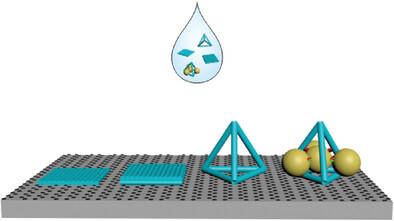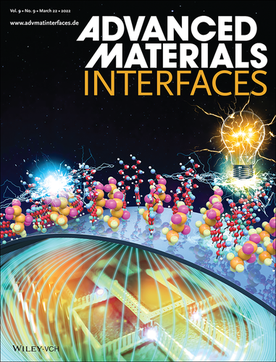在高取向热解石墨上沉积 DNA 纳米结构
IF 4.3
3区 材料科学
Q2 CHEMISTRY, MULTIDISCIPLINARY
引用次数: 0
摘要
DNA 纳米结构的可寻址性与 sp2 碳基材料的电子灵敏度相结合,为开发高灵敏度的生物信号和生物物质的强大灵敏生物设备提供了一条大有可为的途径。实现这一前景的关键是在这些 sp2 碳基底上实现 DNA 纳米结构的高形状保真固定。然而,由于 DNA 纳米结构在这些基底上的稳定性问题,实现这一目标极具挑战性。本研究探讨了 DNA 纳米结构在高取向热解石墨(HOPG)表面上的吸附行为。观察结果表明,DNA 纳米结构在与裸露的 HOPG 相互作用时会出现严重的结构不稳定性。通过改变 HOPG 的表面性质并增强 DNA 纳米结构的刚性,可以实现高形状保真度的 DNA 纳米结构固定化。此外,DNA 四面体折纸被用作一种刚性、精确和可编程的三维框架,用于在 HOPG 表面控制金纳米粒子的图案化,展示了在 sp2 碳基基底上构建等离子体器件和排列其他功能物种以实现特定应用的潜力。这项研究表明,通过与 DNA 纳米结构的整合,sp2 碳基基底的可定制功能化和界面生物器件的定制设计具有潜力。本文章由计算机程序翻译,如有差异,请以英文原文为准。

Deposition of DNA Nanostructures on Highly Oriented Pyrolytic Graphite
The integration of the addressability of DNA nanostructures and the electronic sensitivity of sp2 carbon‐based materials presents a promising avenue for the development of powerful sensitive biodevices for detecting biological signals and substances with high sensitivity. Essential to this prospect is the attainment of high‐shape fidelity immobilization of DNA nanostructures on these sp2 carbon substrates. However, it is challenging due to the stability of DNA nanostructures on these substrates. In this study, the adsorption behavior of DNA nanostructures is explored on a highly oriented pyrolytic graphite (HOPG) surface. The observations revealed a severe structural destabilization of DNA nanostructures upon interacting with bare HOPG. Immobilization of DNA nanostructures with high shape‐fidelity can be achieved by modifying the surface property of HOPG and enhancing the rigidity of DNA nanostructures. In addition, DNA tetrahedron origami is employed as a rigid, precise, and programmable three‐dimensional framework for controlled patterning of gold nanoparticles on HOPG surface, demonstrating the potential for constructing plasmonic devices and arranging other functional species on sp2 carbon‐based substrates for specific applications. This study shows the potential for customizable functionalization of sp2 carbon‐based substrates and tailored design of biodevices at the interface through integration with DNA nanostructures.
求助全文
通过发布文献求助,成功后即可免费获取论文全文。
去求助
来源期刊

Advanced Materials Interfaces
CHEMISTRY, MULTIDISCIPLINARY-MATERIALS SCIENCE, MULTIDISCIPLINARY
CiteScore
8.40
自引率
5.60%
发文量
1174
审稿时长
1.3 months
期刊介绍:
Advanced Materials Interfaces publishes top-level research on interface technologies and effects. Considering any interface formed between solids, liquids, and gases, the journal ensures an interdisciplinary blend of physics, chemistry, materials science, and life sciences. Advanced Materials Interfaces was launched in 2014 and received an Impact Factor of 4.834 in 2018.
The scope of Advanced Materials Interfaces is dedicated to interfaces and surfaces that play an essential role in virtually all materials and devices. Physics, chemistry, materials science and life sciences blend to encourage new, cross-pollinating ideas, which will drive forward our understanding of the processes at the interface.
Advanced Materials Interfaces covers all topics in interface-related research:
Oil / water separation,
Applications of nanostructured materials,
2D materials and heterostructures,
Surfaces and interfaces in organic electronic devices,
Catalysis and membranes,
Self-assembly and nanopatterned surfaces,
Composite and coating materials,
Biointerfaces for technical and medical applications.
Advanced Materials Interfaces provides a forum for topics on surface and interface science with a wide choice of formats: Reviews, Full Papers, and Communications, as well as Progress Reports and Research News.
 求助内容:
求助内容: 应助结果提醒方式:
应助结果提醒方式:


